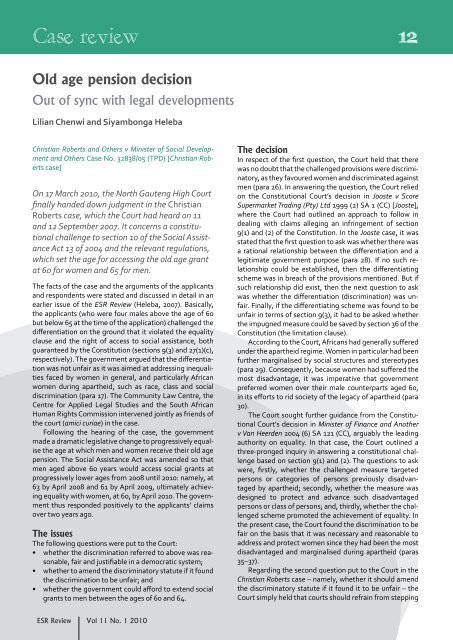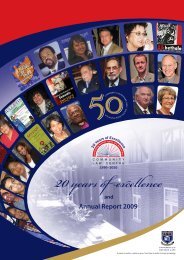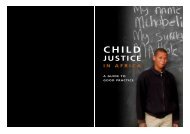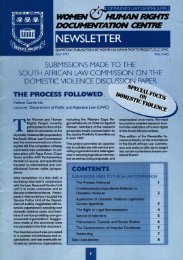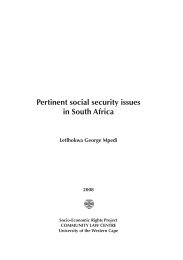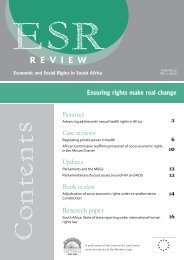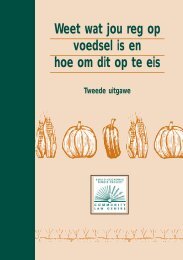ESR Review Volume 11 No 1 - January 2010 - Community Law Centre
ESR Review Volume 11 No 1 - January 2010 - Community Law Centre
ESR Review Volume 11 No 1 - January 2010 - Community Law Centre
Create successful ePaper yourself
Turn your PDF publications into a flip-book with our unique Google optimized e-Paper software.
Case review<br />
12<br />
Old age pension decision<br />
Out of sync with legal developments<br />
Lilian Chenwi and Siyambonga Heleba<br />
Christian Roberts and Others v Minister of Social Development<br />
and Others Case <strong>No</strong>. 32838/05 (TPD) [Christian Roberts<br />
case]<br />
On 17 March <strong>2010</strong>, the <strong>No</strong>rth Gauteng High Court<br />
finally handed down judgment in the Christian<br />
Roberts case, which the Court had heard on <strong>11</strong><br />
and 12 September 2007. It concerns a constitutional<br />
challenge to section 10 of the Social Assistance<br />
Act 13 of 2004 and the relevant regulations,<br />
which set the age for accessing the old age grant<br />
at 60 for women and 65 for men.<br />
The facts of the case and the arguments of the applicants<br />
and respondents were stated and discussed in detail in an<br />
earlier issue of the <strong>ESR</strong> <strong>Review</strong> (Heleba, 2007). Basically,<br />
the applicants (who were four males above the age of 60<br />
but below 65 at the time of the application) challenged the<br />
differentiation on the ground that it violated the equality<br />
clause and the right of access to social assistance, both<br />
guaranteed by the Constitution (sections 9(3) and 27(1)(c),<br />
respectively). The government argued that the differentiation<br />
was not unfair as it was aimed at addressing inequalities<br />
faced by women in general, and particularly African<br />
women during apartheid, such as race, class and social<br />
discrimination (para 17). The <strong>Community</strong> <strong>Law</strong> <strong>Centre</strong>, the<br />
<strong>Centre</strong> for Applied Legal Studies and the South African<br />
Human Rights Commission intervened jointly as friends of<br />
the court (amici curiae) in the case.<br />
Following the hearing of the case, the government<br />
made a dramatic legislative change to progressively equalise<br />
the age at which men and women receive their old age<br />
pension. The Social Assistance Act was amended so that<br />
men aged above 60 years would access social grants at<br />
progressively lower ages from 2008 until <strong>2010</strong>: namely, at<br />
63 by April 2008 and 61 by April 2009, ultimately achieving<br />
equality with women, at 60, by April <strong>2010</strong>. The government<br />
thus responded positively to the applicants’ claims<br />
over two years ago.<br />
The issues<br />
The following questions were put to the Court:<br />
• whether the discrimination referred to above was reasonable,<br />
fair and justifiable in a democratic system;<br />
• whether to amend the discriminatory statute if it found<br />
the discrimination to be unfair; and<br />
• whether the government could afford to extend social<br />
grants to men between the ages of 60 and 64.<br />
The decision<br />
In respect of the first question, the Court held that there<br />
was no doubt that the challenged provisions were discriminatory,<br />
as they favoured women and discriminated against<br />
men (para 26). In answering the question, the Court relied<br />
on the Constitutional Court’s decision in Jooste v Score<br />
Supermarket Trading (Pty) Ltd 1999 (2) SA 1 (CC) [Jooste],<br />
where the Court had outlined an approach to follow in<br />
dealing with claims alleging an infringement of section<br />
9(1) and (2) of the Constitution. In the Jooste case, it was<br />
stated that the first question to ask was whether there was<br />
a rational relationship between the differentiation and a<br />
legitimate government purpose (para 28). If no such relationship<br />
could be established, then the differentiating<br />
scheme was in breach of the provisions mentioned. But if<br />
such relationship did exist, then the next question to ask<br />
was whether the differentiation (discrimination) was unfair.<br />
Finally, if the differentiating scheme was found to be<br />
unfair in terms of section 9(3), it had to be asked whether<br />
the impugned measure could be saved by section 36 of the<br />
Constitution (the limitation clause).<br />
According to the Court, Africans had generally suffered<br />
under the apartheid regime. Women in particular had been<br />
further marginalised by social structures and stereotypes<br />
(para 29). Consequently, because women had suffered the<br />
most disadvantage, it was imperative that government<br />
preferred women over their male counterparts aged 60,<br />
in its efforts to rid society of the legacy of apartheid (para<br />
30).<br />
The Court sought further guidance from the Constitutional<br />
Court’s decision in Minister of Finance and Another<br />
v Van Heerden 2004 (6) SA 121 (CC), arguably the leading<br />
authority on equality. In that case, the Court outlined a<br />
three-pronged inquiry in answering a constitutional challenge<br />
based on section 9(1) and (2). The questions to ask<br />
were, firstly, whether the challenged measure targeted<br />
persons or categories of persons previously disadvantaged<br />
by apartheid; secondly, whether the measure was<br />
designed to protect and advance such disadvantaged<br />
persons or class of persons; and, thirdly, whether the challenged<br />
scheme promoted the achievement of equality. In<br />
the present case, the Court found the discrimination to be<br />
fair on the basis that it was necessary and reasonable to<br />
address and protect women since they had been the most<br />
disadvantaged and marginalised during apartheid (paras<br />
35–37).<br />
Regarding the second question put to the Court in the<br />
Christian Roberts case – namely, whether it should amend<br />
the discriminatory statute if it found it to be unfair – the<br />
Court simply held that courts should refrain from stepping<br />
<strong>ESR</strong> <strong>Review</strong> Vol <strong>11</strong> <strong>No</strong>. 1 <strong>2010</strong>


